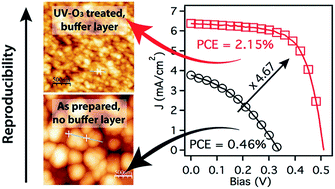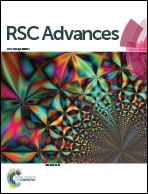Fabrication conditions for efficient organic photovoltaic cells from aqueous dispersions of nanoparticles†
Abstract
For environmentally friendly and cost-effective manufacturing of organic photovoltaic (OPV) cells, it is highly desirable to replace haloarenes with water as the active layer fabrication solvent. Replacing an organic solvent with water requires retooling the device fabrication steps. The optimization studies were conducted using poly(3-hexylthiophene) (P3HT) and [6,6]-phenyl C61 butyric acid methyl ester (PCBM) as active layer materials. These materials were dispersed in water as blend and separate nanoparticles using the miniemulsion method. Topologies of the active layers were investigated using atomic force microscopy and electron microscopy techniques. We have identified two essential steps to fabricate efficient OPVs from aqueous dispersions: (1) treatment of the hole-transport layer with UV-O3 to make the surface hydrophilic and (2) the use of an electron-transporting buffer layer for efficient charge extraction. We have also identified relative humidity and substrate temperature as key fabrication parameters for obtaining uniform active layer films. The OPV devices were fabricated using PEDOT:PSS as the hole-transport layer and PCBM as electron-transport layer with Ca/Al as the counter electrode. Efficiencies of 2.15% with a fill factor over 66% were obtained; the efficiency and the fill-factor is the highest among all aqueous processing of P3HT–PCBM nanoparticle solar cells.


 Please wait while we load your content...
Please wait while we load your content...